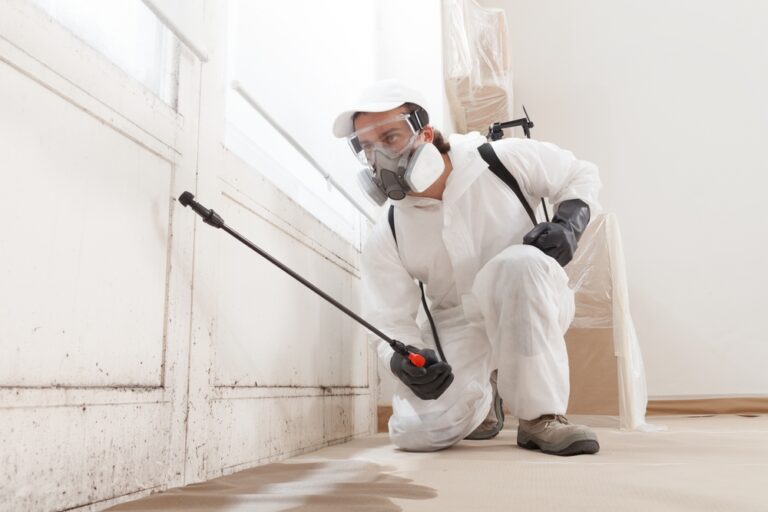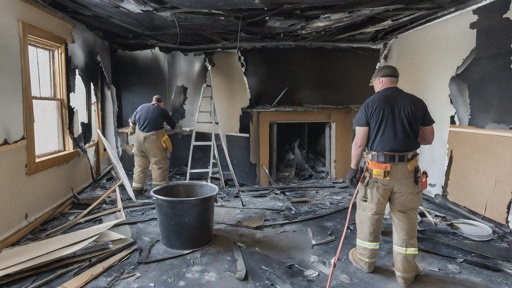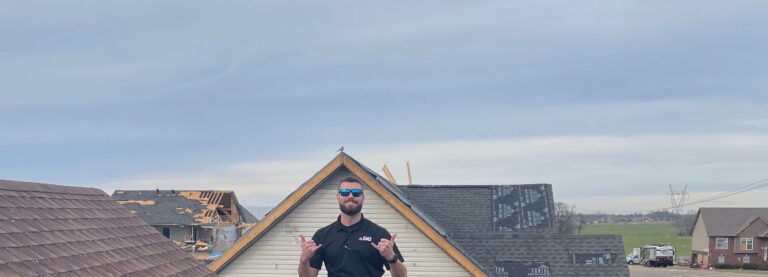Introduction to Fire Damage Restoration
Fire damage restoration is a crucial process that ensures affected properties can be safely returned to their pre-loss condition. This article delves into the intricacies of restoring a home after a fire, elucidating the methods and technologies employed by restoration professionals. Understanding the restoration process, tools, and preventive measures is essential for homeowners seeking to safeguard their properties and families.
Fire damage restoration involves several key steps, starting with damage assessment and mitigation to prevent further harm. Restoration professionals utilize specialized equipment like air scrubbers and thermal foggers to remove smoke odors and purify the air. The restoration process also includes cleaning surfaces, eliminating soot residues, and repairing structural damage. Implementing preventive measures like installing smoke detectors and fire extinguishers can significantly reduce fire-related risks in homes. Homeowners should work closely with restoration experts to ensure a thorough and effective restoration process.
Understanding Fire Damage
Fire damage can vary significantly depending on the source of the fire, the materials involved, and the duration of the blaze. Common types of damage include charring of materials, smoke damage, and water damage from firefighting efforts. Each of these damage types requires specific restoration techniques to address effectively. For instance, smoke can infiltrate walls, ceilings, and furniture, leading to lingering odors and potential health concerns.
Furthermore, the aftermath of a fire can pose safety risks, including structural weaknesses and hazardous materials. Understanding these hazards is critical for individuals attempting to assess damage without professional assistance. The extent of fire damage often necessitates the expertise of restoration specialists who can accurately evaluate and mitigate risks, ensuring a safe and thorough restoration process.
The Importance of Timely Restoration
Time is a vital factor in fire damage restoration. The longer it takes to initiate the restoration process, the more severe the damage can become. Smoke and soot can cause permanent discoloration of surfaces, while water damage can lead to mold growth if not addressed promptly. Engaging restoration services quickly can reduce overall costs and prevent further deterioration of the property.
Moreover, timely restoration can significantly affect the emotional recovery of homeowners. After experiencing such a traumatic event, restoring a sense of normalcy in the home environment can aid in the psychological healing process. Rebuilding and repairing symbolize resilience and hope, allowing families to move forward.
The Fire Damage Restoration Process
Assessment and Inspection
The restoration process begins with a thorough assessment of the property. Professionals inspect the extent of fire damage, including structural integrity, smoke damage, and water-related issues from firefighting efforts. This initial evaluation is crucial for developing a comprehensive restoration plan tailored to the specific needs of the property. Restoration experts utilize specialized tools to assess damage accurately, ensuring that no hidden issues remain unaddressed.
Documentation is also an essential part of this phase. Professionals will take photographs and notes to create a detailed report, which can be invaluable for insurance claims and future reference. Understanding the full scope of damage not only informs restoration efforts but also provides clarity for homeowners navigating recovery options.
Securing the Property
Once the assessment is complete, securing the property is the next step. This involves boarding up windows, doors, and other openings to prevent unauthorized entry and further damage from the elements. Securing the site not only protects the property but also preserves evidence for insurance purposes. Ensuring safety for the inhabitants and professionals entering the property is paramount during this stage.
Additionally, any hazardous materials, like burnt debris or chemicals, must be handled carefully. Professionals are trained to identify and mitigate potential dangers, safeguarding both their team and the homeowners. This step is essential for ensuring that the restoration process can proceed without further incidents.
Water Removal and Drying
In many cases, firefighting efforts result in significant water damage. The next phase of restoration involves removing standing water and thoroughly drying out the affected areas. Restoration professionals use powerful pumps and dehumidifiers to extract water and moisture from the building materials and air. Effective drying is critical to prevent mold growth and further structural damage.
This phase often includes monitoring moisture levels in the air and the materials themselves to ensure complete drying. Specialists may also employ air movers and fans to expedite this process. The goal is to create a dry environment conducive to further restoration work while minimizing the risk of secondary damages.
Cleaning and Deodorization
Once the property is dry, restoration professionals focus on cleaning and deodorizing the affected areas. This process involves removing soot, smoke residue, and any odor-causing particles from surfaces. Various cleaning techniques and solutions are employed depending on the material and severity of the damage. For example, soft surfaces such as upholstery may require steam cleaning, while hard surfaces may need specialized cleaning agents.
Deodorization is a critical aspect of this phase, as smoke odors can linger long after the visible damage is addressed. Professionals use advanced techniques, including ozone treatment and thermal fogging, to neutralize odors at their source. The aim is to create a safe and welcoming environment for the occupants, free from the reminders of the traumatic event.
Restoration and Reconstruction
The final stage of fire damage restoration involves restoring the property to its pre-loss condition. This might include repairing or replacing damaged structural elements such as walls, roofs, and flooring. Depending on the extent of the damage, the restoration process may encompass minor repairs or significant reconstruction efforts. A licensed contractor often collaborates with restoration professionals to ensure compliance with building codes and safety regulations.
Moreover, restoration is not only about repairing damage but also about improving the property’s resilience to future incidents. Homeowners may choose to upgrade fire-resistant materials or enhance fire safety features during the restoration process, ensuring long-term security and peace of mind.
Tools and Technologies Used in Fire Damage Restoration
Advanced Cleaning Equipment
Restoration professionals utilize an array of advanced cleaning equipment to tackle fire damage effectively. High-powered vacuums, steam cleaners, and specialized soot removers are essential tools for cleaning surfaces and fabrics affected by smoke. These machines are designed to reach deep into porous materials, ensuring thorough cleaning and restoration.
In addition to cleaning equipment, air scrubbers are commonly used to remove airborne contaminants and odors. These devices filter and purify the air, creating a healthier indoor environment for both the restoration team and the occupants. Advanced technology not only enhances the efficiency of the restoration process but also improves the overall outcome for the property.
Dehumidification Techniques
Dehumidification is a critical component of the fire damage restoration process. High humidity can lead to mold growth, which poses health risks and complicates restoration efforts. Restoration professionals deploy specialized dehumidifiers to maintain optimal humidity levels in the affected areas. These machines extract moisture from the air, creating a dry environment conducive to effective restoration.
The use of thermal imaging cameras is also beneficial during the drying process. These cameras can detect hidden moisture behind walls and in ceilings, allowing professionals to address potential water damage before it becomes a more significant issue. This proactive approach not only enhances restoration efficiency but also helps prevent future complications.
The Role of Professionals in Fire Damage Restoration
Expertise and Training
Restoration after a fire requires specialized knowledge and training. Professionals in the field are equipped with the skills necessary to assess damage accurately, implement effective restoration techniques, and ensure safety throughout the process. Many restoration companies are certified by organizations such as the Institute of Inspection, Cleaning and Restoration Certification (IICRC), which sets standards for the industry.
These experts understand the complexities of fire damage and the specific methods needed to address each type of damage. Their experience allows them to navigate the challenges of restoration efficiently, providing homeowners with peace of mind during a stressful time. Hiring professionals ensures that the restoration process is handled with the utmost care and expertise.
Insurance Claims Assistance
Navigating the insurance claims process can be daunting for homeowners after a fire. Restoration professionals often assist clients in this regard, providing documentation and evidence needed to support claims. Their experience with insurance companies and knowledge of what is required can streamline the process, making it less burdensome for clients.
Having experts on your side can significantly impact the outcome of your claim, ensuring you receive fair compensation for the damages incurred. Restoration companies frequently work closely with insurance adjusters, helping to facilitate communication and address any questions or concerns that may arise during the claims process.
Preventive Measures and Fire Safety Tips
Home Security and Fire Alarms
Prevention is the best strategy when it comes to fire safety. Homeowners should invest in quality fire alarms and smoke detectors, ensuring they are installed in key areas of the home. Regular maintenance, including battery replacement and testing, is vital to ensure these devices function correctly when needed.
In addition to alarms, homeowners can enhance fire safety by implementing fire-resistant materials in their homes. This includes using fire-retardant paints, non-combustible siding, and fire-resistant roofing materials. Taking these proactive steps can significantly reduce the risk of fire damage and protect the family and property.
Creating an Emergency Plan
Having a well-thought-out emergency plan can save lives in the event of a fire. Homeowners should create and communicate an escape plan that includes multiple exit routes and a designated meeting point outside the home. Regularly practicing this plan ensures that all family members are prepared and know what to do in an emergency.
Additionally, keeping a well-stocked emergency kit with essentials—such as water, flashlights, and first aid supplies—can provide critical support in the aftermath of a fire. Ensuring that all family members understand the importance of fire safety and emergency preparedness can empower them to act swiftly and effectively in case of a fire.
Conclusion
The Value of Professional Fire Damage Restoration
Professional fire damage restoration is essential for returning a property to its pre-loss condition while ensuring safety and compliance with regulations. The expertise, tools, and technologies employed by restoration professionals play a significant role in mitigating damage and facilitating recovery. By acting promptly and engaging qualified specialists, homeowners can restore their properties effectively and minimize the lasting impacts of a fire.
In addition to emergency kits, creating a fire escape plan with designated meeting spots can enhance overall household safety. Regularly testing smoke alarms and carbon monoxide detectors is crucial for early fire detection and prevention. Practice fire drills with your family to ensure everyone knows how to evacuate safely and efficiently. Educate children about fire safety measures and the importance of following evacuation procedures. Taking proactive measures and staying prepared can make a significant difference in the event of a fire.
Final Thoughts on Recovery and Restoration
Recovering from a fire is a challenging journey, yet with the right support and knowledge, homeowners can rebuild and restore their lives. Understanding the restoration process, embracing preventive measures, and recognizing the importance of professional assistance can empower families to navigate this difficult experience. The road to recovery may be long, but with resilience and preparation, it is entirely possible to emerge stronger and safer.
Efficient restoration professionals utilize their expertise, tools, and technologies to aid in mitigating damage and expediting recovery processes. Homeowners who act promptly and enlist qualified specialists can effectively restore their properties, reducing the enduring consequences of a fire incident. The journey of recuperating from a fire is undoubtedly arduous; however, with appropriate support and knowledge, individuals can reconstruct their lives successfully. Familiarizing oneself with the restoration procedures, adopting preventive measures, and acknowledging the significance of professional intervention can empower families to navigate through this challenging ordeal. While the path to recovery may seem lengthy, resilience and preparedness can lead to a stronger and more secure outcome. When you call Apex Restoration DKI you get the full benefits of a fast, efficient, and purposeful fire damage restoration company. Call us today!





